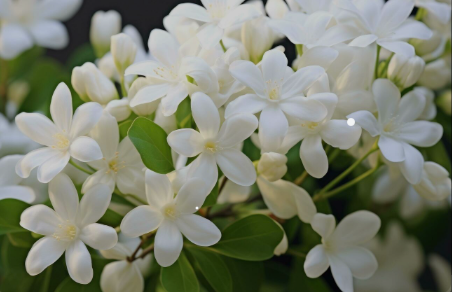Ready to bring the sweet scent of jasmine into your home or garden? Propagating jasmine flowers from cuttings is a rewarding and cost-effective way to expand your green space. Whether you’re a seasoned gardener or just starting out, this simple technique allows you to multiply your favorite blooms with ease. Join us as we delve into the art of propagating jasmine plants and watch your garden blossom before your eyes!
Benefits of Propagating Jasmine Flower from Cuttings
Propagating Jasmine Flower from cuttings comes with a host of benefits that make it a rewarding and satisfying gardening endeavor. One of the main advantages is the ability to create new plants that are genetically identical to the parent plant, ensuring consistency in bloom color and fragrance. This method also allows for quicker growth compared to growing jasmine from seeds, as cuttings already have established roots.
Moreover, propagating jasmine from cuttings can be a cost-effective way to expand your garden or share plants with friends and family without having to purchase new ones. It’s a great way to preserve treasured varieties or rare cultivars that may not be readily available commercially.
Additionally, by propagating jasmine flower from cuttings, you can enjoy the satisfaction of nurturing and watching your plants grow and thrive under your care. It’s a fulfilling process that connects you more intimately with nature and the beauty of these fragrant flowers.
Materials Needed for Propagation
When it comes to propagating Jasmine flowers from cuttings, having the right materials is crucial for success. To get started, you will need sharp and clean pruning shears to take cuttings from a healthy Jasmine plant. Make sure your tools are sanitized to prevent any infections on the cutting.
Next, prepare some rooting hormone powder or gel to encourage root growth in the new cuttings. This will increase their chances of successfully establishing themselves as new plants. Additionally, have some small pots filled with well-draining soil ready for planting the cuttings.
Watering can is essential for keeping the soil moist but not waterlogged during the propagation process. Find a warm and bright location where your newly propagated Jasmine plants can receive indirect sunlight to thrive and grow strong roots. With these materials at hand, you’ll be all set to propagate beautiful Jasmine flowers successfully!
Step-by-Step Guide to Propagating Jasmine Flower from Cuttings
Propagating jasmine flower from cuttings is an exciting way to expand your garden. To begin, select a healthy and mature jasmine plant to take cuttings from. It’s important to choose stems that are free of disease or pests. Using sharp scissors or pruning shears, snip a 4-6 inch cutting just below a leaf node.
Remove the lower leaves from the cutting to expose the nodes where roots will form. Dip the cut end into rooting hormone powder to encourage root growth. Next, prepare a pot with well-draining soil and create a hole using a pencil or stick.
Place the cutting into the hole and gently press the soil around it to secure it in place. Water thoroughly but avoid waterlogging the soil as this can lead to rotting. Keep the cutting in indirect sunlight and maintain consistent moisture levels by misting regularly.
In a few weeks, you should start seeing roots forming. Once roots have established, you can transplant your new jasmine plant into its permanent home in your garden or container for beautiful blooms all season long!
Caring for Newly Propagated Jasmine Plants
Once you have successfully propagated your jasmine plants from cuttings, it is crucial to provide them with the proper care to ensure their healthy growth. Newly propagated jasmine plants are delicate and require special attention in the initial stages.
Make sure to place your newly rooted jasmine cuttings in a warm and bright location, but away from direct sunlight. Keep the soil consistently moist but not waterlogged to promote root development. Regularly misting the leaves can help create a humid environment that aids in their growth.
As your jasmine plants start to establish themselves, consider transplanting them into individual pots with well-draining soil. Fertilize occasionally with a balanced liquid fertilizer to encourage lush foliage and abundant blooms.
Monitor for any signs of pests or diseases, and promptly address any issues that may arise. With proper care and attention, your newly propagated jasmine plants will thrive and reward you with their fragrant flowers in no time!
Troubleshooting Common Issues with Propagation
Encountering issues during the propagation process of jasmine flowers is not uncommon, but with some troubleshooting, you can overcome these challenges. One common problem is poor root development after cutting placement. To address this, ensure the cuttings have enough moisture and warmth to stimulate root growth effectively.
Another issue that may arise is wilting or yellowing leaves on the cuttings. This could indicate excessive sunlight exposure or lack of humidity. Consider moving the cuttings to a shadier spot or using a misting system to increase moisture in the air around them.
It’s also essential to watch out for mold or fungal growth on the cuttings. This can be prevented by ensuring proper ventilation and avoiding overwatering. If mold appears, gently wipe it off with a damp cloth and adjust your care routine accordingly.
By being attentive to these common problems and making necessary adjustments, you’ll improve your success rate in propagating healthy jasmine plants from cuttings.
Conclusion
Propagating jasmine flowers from cuttings is a rewarding and sustainable way to expand your garden. By following the step-by-step guide and providing proper care to the newly propagated plants, you can enjoy beautiful blooms and delicate fragrance in your garden. Remember to be patient with the process and troubleshoot any issues that may arise along the way. With dedication and love for gardening, you can successfully propagate jasmine flowers and create a flourishing garden filled with these lovely blooms. Happy gardening!
